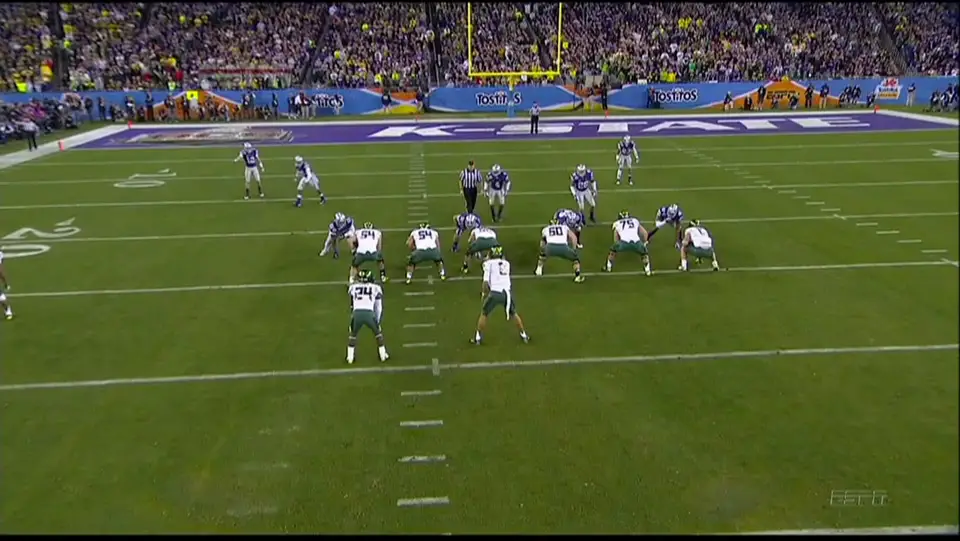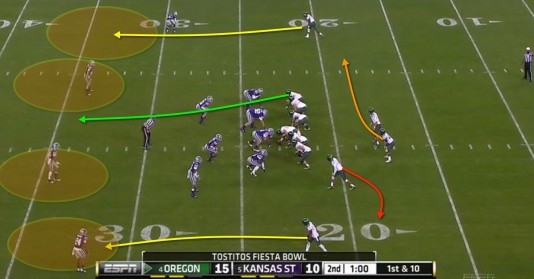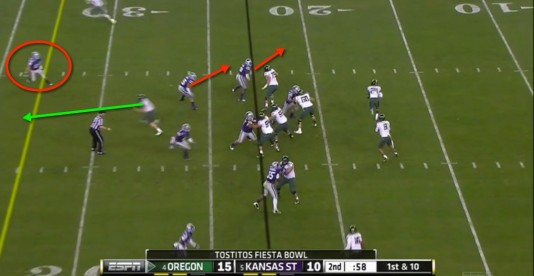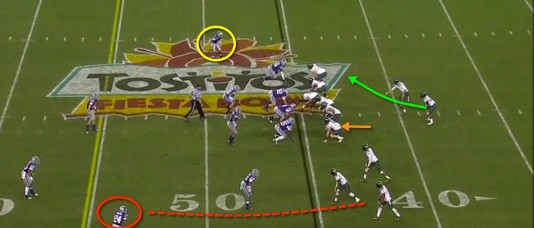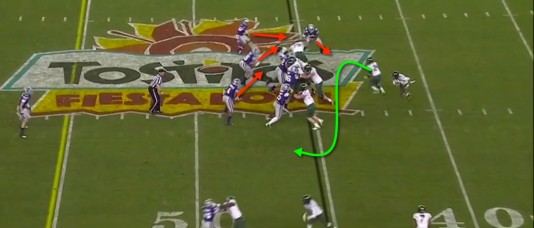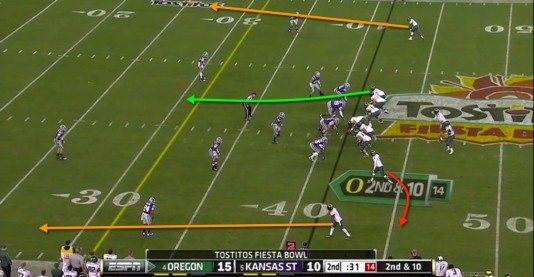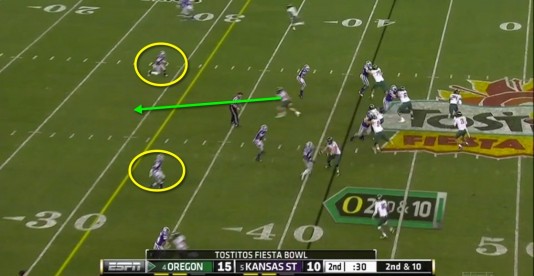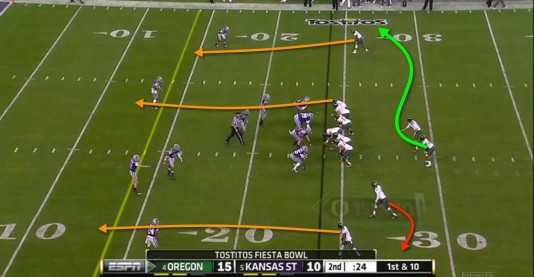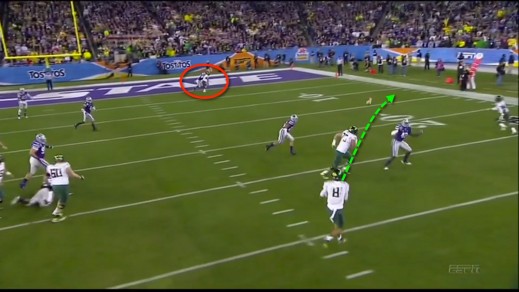One of the most exciting moments from the 2013 Fiesta Bowl had to be the half-ending touchdown drive Oregon put together to effectively finish off the Kansas State Wildcats. After the Wildcats had marched down the field and threatened to take a 17-15 lead, Oregon’s defense held tight and forced KSU to kick a field goal, which they promptly missed, giving Oregon the ball back with exactly one minute left in the first half.
At the time, things were stacked up against the Ducks, considering they hadn’t even earned a first down since the first quarter, and the Kansas State defense seemed to be gaining confidence with every possession.
However, out-scheming Chip Kelly often takes more defensive adjustments than it would for any other coach in the game today simply because when Oregon “gets on a roll,” it becomes incredibly hard for a defensive coordinator to identify and call proverbial counters to Oregon’s rapid pace and subsequent play calls, effectively handcuffing the defense to a handful of coverages.
When a team runs a no-huddle offense, it is handicapping itself as well. To start, the offense will probably not be changing personnel, thus limiting both play calling and formations. Unfortunately for KSU’s defense, Coach Kelly is pretty good at mixing up alignments on the fly, even if the personnel isn’t very diverse. For instance, Oregon can go from a 2×2 set and run inside, to a 3×1 set for a bubble screen, to an unbalanced 4×0 set for another run, back to a 2×2 formation for a pass, all with the same personnel. On the final drive of the first half of the Fiesta Bowl, Oregon used three wide receivers, a tight end, and a running back for its personnel, and three distinct concepts on the fly to carve up the Kansas State defense.
Oregon got things rolling with its favorite deep threat play which combines both play action and vertical routes.
In the image above, you can see the PA-Vert play diagrammed. The outside receivers (yellow arrows) will attack the outermost deep thirds of the field while the tight end (green arrow) will attack the middle of the field. The slot receiver (red arrow) will run a bubble route to the quarterback’s left, acting as a checkdown, and the running back (orange arrow) will carry out his fake, and act as a checkdown to the wide side of the field. As you can see, symmetry in routes, both deep downfield and in the flats force the KSU defense to guard just about every portion of the field.
As the running back carries out his fake, two KSU linebackers bite and head to the perimeter to guard the running back. With the middle of the field vacated, the tight end, Lyerla (green arrow), is sprinting untouched downfield, outrunning the safety (red circle) to gain 23 yards to start the drive off.
Just after the big passing play, Oregon ran right up to the ball with the same personnel, but in a drastically different alignment. From 2×2 to an unbalanced 4×0 formation (tight end is covered on the line of scrimmage, as shown by the orange arrow above). Kansas State immediately shifts towards the unbalanced side of the formation, and brings its safety to the strong side of the formation. As we’ve seen many times before, Oregon chooses a running play to the weak side of the formation, despite the advantage of the unbalanced formation.
Kansas State was well prepared for Oregon’s tendencies to run away from their extra blocker in the this formation, and crashes hard to stop the weak side run. Four Kansas State defenders on the second level (red arrows) sell out to their left, leaving a big hole on the opposite side of the play. Barner, a seasoned veteran of the zone scheme, recognizes the defense’s aggressiveness and cuts back for another big gain on the second play of the drive.
Now Oregon has run a passing play and a running play from different formations with under a minute to play in the half.
After an unsuccessful fake screen call on first down, Oregon returns to its original 2×2 formation, and runs the same exact play (play action-verts). With no defender directly in front of Lyerla, the tight end can find the same gap in coverage as he did earlier in the drive.
Lyerla (green arrow above) beats both deep safeties yet again for another big gain. Now Oregon’s drive has comprised of PA-Verts, Inside Zone, and PA-Verts again, with only two different formations.
With time ticking off, Oregon went back to the same formation, and same PA-Verts play again, but this time it becomes obvious that Kansas State has become keen to the Lyerla-seam route.
In the image above, you can see the same play from the previous image shown from behind. As Lyerla heads upfield, three KSU defenders key in on Lyerla instead of heading to their respective zones. The defender furthest to the right is responsible for checking Barner and making sure the running back does not reach the flat before the coverage does. While he checks Lyerla, the defender is a few steps behind Barner on his way to the perimeter.
Mariota rolls out to his right and finds Barner in the flat, now wide open, thanks to Lyerla’s previous action, and a great downfield block from an Oregon wide receiver (red circle). Marcus flings an easy lob pass out to Barner, who strides into the endzone, and puts Oregon up 22-10, a difference that proved too much for Kansas State to overcome.
Running a no huddle offense might present several challenges for a coaching staff, but forcing a defense to play off of pure reaction as opposed to identifying formations, plays, and tendencies can help your offense immensely. As soon as a defense is on its heels, Chip Kelly and Mark Helfrich have a really amazing ability to find which plays will work the best against a basic defense. As we saw on this drive, Oregon’s manipulation of formations caused KSU to defend without discipline, and allowed the Ducks to find a checkdown route for a touchdown.
Related Articles:
Josh is a College Football enthusiast from sunny Southern California. He has written for several self-operated prep sports blogs, as well as multiple SB Nation sites. In High School, Josh played football for four years, and helped create and operate the team’s no-huddle system. Most of Josh’s football knowledge branches from watching College Football his entire life, and is backed up by his first hand experience in both option and spread offenses. Above all, though, he is a proud student at the University of Oregon.
@joshschlichter

